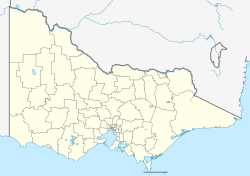Echuca | ||||||||||||||||||
|---|---|---|---|---|---|---|---|---|---|---|---|---|---|---|---|---|---|---|
| PTV regional rail station | ||||||||||||||||||
 Southbound view of station platform and building with a VLocity train at the platform, August 2007 | ||||||||||||||||||
| General information | ||||||||||||||||||
| Location | 116 Sturt Street, Echuca, Victoria 3564 Shire of Campaspe Australia | |||||||||||||||||
| Coordinates | 36°07′52″S144°45′12″E / 36.131138°S 144.753387°E | |||||||||||||||||
| Owned by | VicTrack | |||||||||||||||||
| Operated by | V/Line | |||||||||||||||||
| Line(s) | ||||||||||||||||||
| Distance | 249.99 kilometres from Southern Cross | |||||||||||||||||
| Platforms | 1 | |||||||||||||||||
| Tracks | 5 | |||||||||||||||||
| Connections |
| |||||||||||||||||
| Construction | ||||||||||||||||||
| Structure type | At-grade | |||||||||||||||||
| Parking | Yes | |||||||||||||||||
| Accessible | Yes | |||||||||||||||||
| Other information | ||||||||||||||||||
| Status | Operational, staffed part-time | |||||||||||||||||
| Station code | ECH | |||||||||||||||||
| Fare zone | Myki not available. Paper ticket only. | |||||||||||||||||
| Website | Public Transport Victoria | |||||||||||||||||
| History | ||||||||||||||||||
| Opened | 19 September 1864 | |||||||||||||||||
| Services | ||||||||||||||||||
| One per weekday to Southern Cross (two on weekends). Trains travelling in the opposite direction terminate here.
| ||||||||||||||||||
| ||||||||||||||||||
| Official name | Echuca Railway Station Complex | |||||||||||||||||
| Designated | 20 August 1982 | |||||||||||||||||
| Reference no. | H1059 [1] | |||||||||||||||||
| ||||||||||||||||||
Echuca railway station is located on the Deniliquin line in Victoria, Australia. It serves the town of the same name, and opened on 19 September 1864. [2]
Contents
It is the northern-most operating passenger railway station on the Deniliquin line, and is the terminus for Echuca line services. It also serves as the terminus of the freight-only Toolamba–Echuca line. The Deniliquin line extends northwards, over the New South Wales state border, and is open for freight traffic. Freight sidings and a silo are located opposite the station.

